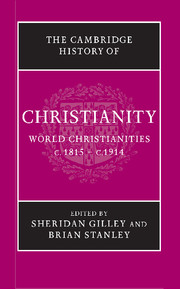Book contents
- Frontmatter
- 1 Introduction
- PART I CHRISTIANITY AND MODERNITY
- 2 The papacy
- 3 Theology and the revolt against the Enlightenment
- 4 The growth of voluntary religion
- 5 Catholic revivalism in worship and devotion
- 6 Women preachers and the new Orders
- 7 Church architecture and religious art
- 8 Musical trends and the western church: a collision of the ‘ancient’ and ‘modern’
- 9 Christianity and literature in English
- 10 Christian social thought
- 11 Christianity and the sciences
- 12 History and the Bible
- 13 Popular religion and irreligion in countryside and town
- PART II THE CHURCHES AND NATIONAL IDENTITIES
- PART III THE EXPANSION OF CHRISTIANITY
- Select General Bibliography
- Chapter Bibliography
- Index
- References
4 - The growth of voluntary religion
from PART I - CHRISTIANITY AND MODERNITY
Published online by Cambridge University Press: 28 March 2008
- Frontmatter
- 1 Introduction
- PART I CHRISTIANITY AND MODERNITY
- 2 The papacy
- 3 Theology and the revolt against the Enlightenment
- 4 The growth of voluntary religion
- 5 Catholic revivalism in worship and devotion
- 6 Women preachers and the new Orders
- 7 Church architecture and religious art
- 8 Musical trends and the western church: a collision of the ‘ancient’ and ‘modern’
- 9 Christianity and literature in English
- 10 Christian social thought
- 11 Christianity and the sciences
- 12 History and the Bible
- 13 Popular religion and irreligion in countryside and town
- PART II THE CHURCHES AND NATIONAL IDENTITIES
- PART III THE EXPANSION OF CHRISTIANITY
- Select General Bibliography
- Chapter Bibliography
- Index
- References
Summary
Charles Haddon Spurgeon epitomised the success of nineteenth-century voluntary religion. From the early 1860s to the beginning of the 1890s the celebrated Baptist preached regularly at his Metropolitan Tabernacle to congregations of around 6,000 people. His vivid, witty and uninhibited approach in the pulpit made him one of the sights of London. By 1865 his sermons had a weekly sale of some 25,000 copies and were syndicated to newspapers throughout the English-speaking world. Although he enjoyed none of the privileges of the established Church of England – and in part because of that circumstance – Spurgeon achieved enormous popularity. The Nonconformists of England whom he championed were at the height of their influence. The descendants of the Puritans, who had left the established church in the seventeenth century and whose ranks had been augmented in the eighteenth by the Methodists, had grown to a position of rough numerical equality with the Church of England. In 1851 whereas some 19.7 per cent of the population attended the Church of England, Nonconformity enjoyed the support of as high a proportion as 18.6 per cent. Dissenters – a term equivalent to ‘Nonconformists’ – had mushroomed over the previous seventy or eighty years. Between 1773 and 1851 the number of Nonconformist congregations had multiplied tenfold, far exceeding the increase in population. Expansion relative to population, at least as measured by membership, continued after 1851 among the Free Churches for another quarter-century. There were parallel surges of church growth outside the state-supported churches in other parts of the British Isles, in the lands settled from Britain during the century and above all in the United States.
- Type
- Chapter
- Information
- The Cambridge History of Christianity , pp. 53 - 69Publisher: Cambridge University PressPrint publication year: 2005
References
- 1
- Cited by

